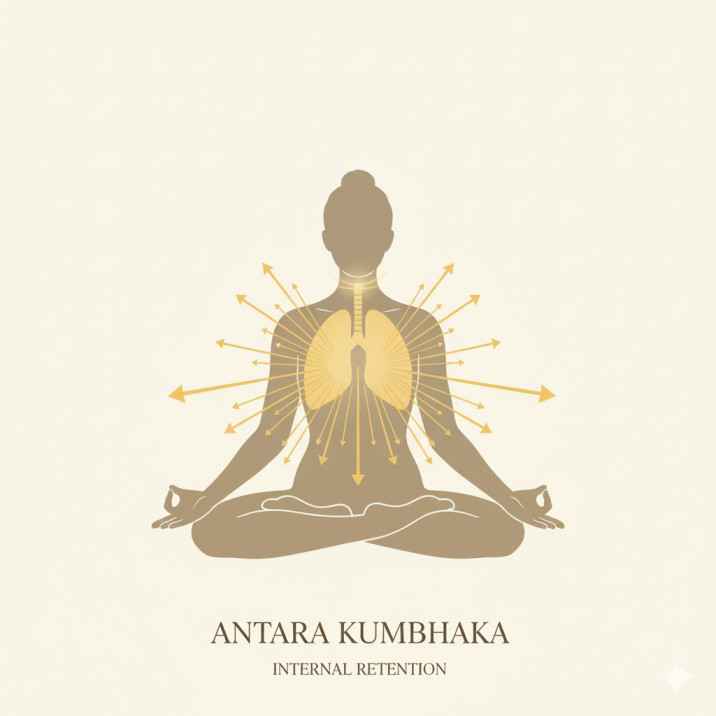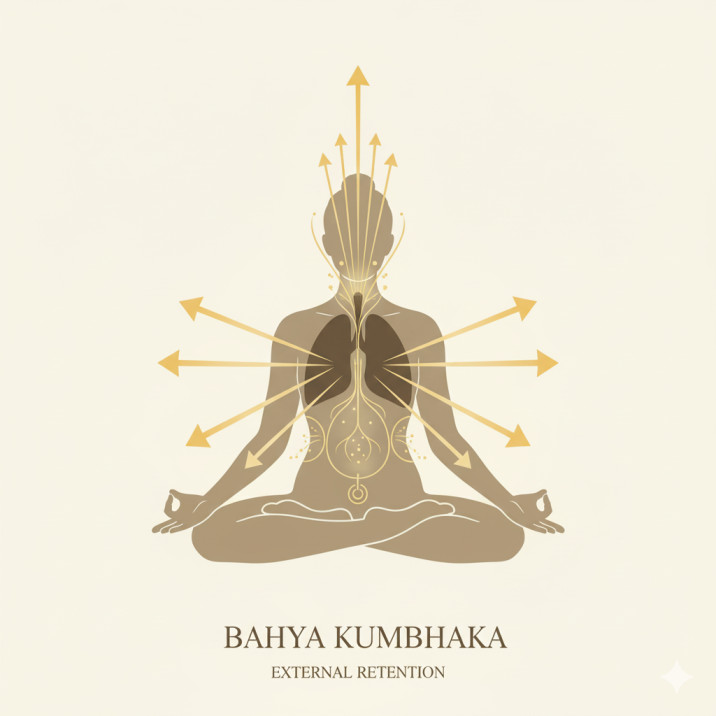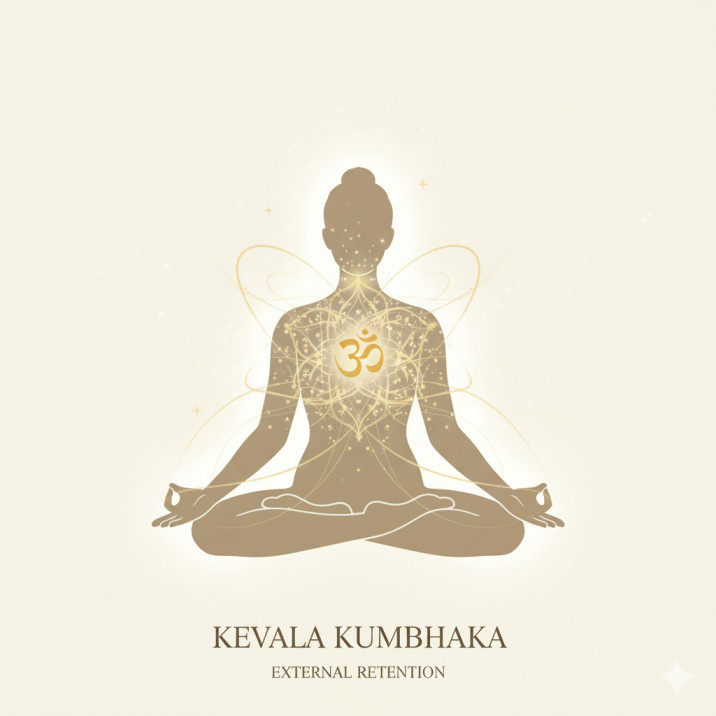
The phrase Bahya comes from Sanskrit, which means “exterior” or “exterior.” Pranayama refers back to the apply of yogic respiration methods.
In Bahya Pranayama, you’re taking a deep breath in after which exhale fully to empty your lungs. After exhaling, you maintain your breath out for just a few seconds and apply particular bandhas (physique locks). This act of retaining the breath after exhalation is what makes this pranayama distinctive.
In yoga, breath retention is known as Kumbhaka. Since this method entails holding the breath exterior, it is usually generally known as Bahir Kumbhaka or Bahir Pranayam (Bahir means “exterior”).
Throughout the apply, three bandhas are used to boost lung operate and stimulate totally different inner organs. Common apply of Bahya Pranayama helps activate the stomach organs, enhancing digestion and elimination. It strengthens the respiratory system and brings a way of steadiness between physique and thoughts. This pranayama can also be believed to assist handle thyroid imbalance and scale back signs of diabetes.
Tips on how to do bahya pranayama(step-by-step)
It’s finest to practise Bahya Pranayama on an empty abdomen. Should you additionally do Kapalbhati Pranayama, practise Bahya Pranayama proper after it. Newbies can begin with 5–7 minutes of apply and step by step enhance the breath retention time as they progress.
- Sit in a cross-legged posture, most well-liked Sukhasana or Padmasana.
- Take a deep inhalation after which exhale, fully emptying your lungs.
- Maintain your breath out and convey your consideration to carry out 3 Bandhas;
- When you’ve got a stiff neck or every other situation, you wouldn’t have to drag down your chin. Hold your head straight and look ahead.
- Maintain your breath for 3-5 seconds together with these 3 physique locks (collectively known as Maha Bandha).
- Launch these locks by inhaling deeply.
- Breath usually for just a few seconds and repeat the method.

Superior practitioners can incorporate the apply of Agnisar kriya together with Bahya Pranayama. For this, on the finish of the 4th step, loosen up your stomach muscle groups and churn them across the central abs. It’s thought of very efficient in stimulating the digestive fireplace.
Respiratory ratio
The best ratio of inhaling Bahya pranayama is 1:2:3 i.e. if inhale is of 1 second, then exhalation needs to be for two seconds and eventually, the breath needs to be held out for 3 seconds. Equally, if inhale is doubled or tripled, then exhalation and breathe retention will probably be doubled or tripled additionally.
Bahya pranayama advantages

Bahya Pranayama is a yogic respiration method that entails holding the breath after exhalation (exterior retention). It helps enhance digestion, strengthens stomach organs, cleanses the lungs, and calms the thoughts. Common apply of Bahya Pranayama additionally helps diabetes administration, improves focus, and balances the thoughts and physique.
1. Improves digestion and strengthens stomach organs
In Bahya Pranayama, you maintain your breath out and draw the stomach inward. This motion gently massages the abdomen and intestines, enhancing their flexibility and performance. It helps wholesome digestion and helps scale back issues like acidity, gasoline, and constipation.
2. Prevents points associated to stomach organs
This pranayama will increase blood circulation to important organs such because the abdomen, liver, spleen, kidneys, and uterus. It retains these organs energetic and wholesome, enhancing their pure capabilities and serving to to stop points like hernia or urinary infections.
3. Cleanses and strengthens the respiratory system
Bahya Pranayama absolutely empties the lungs, clearing stale air and toxins. This improves lung capability and effectivity. Research have proven that pranayama practices can improve respiratory well being and help cardiovascular operate.
4. Handle diabetes
The contraction of stomach muscle groups throughout this apply stimulates the pancreas, selling higher insulin secretion. Constant apply could assist steadiness blood sugar ranges and scale back signs of diabetes.
5. Helps kundalini awakening
Bahya Pranayama prompts vitality channels within the physique and prepares the thoughts for meditation. It helps awaken Kundalini vitality, bringing a deeper sense of consciousness, peace, and inside stability.
6. Will increase focus and focus
Making use of the three bandhas calms the nervous system and improves blood circulation to the mind. This results in higher focus, sharper reminiscence, and psychological readability. The apply cultivates a relaxed and centered frame of mind.
7. Promotes mind-body steadiness
When breath retention and bandhas are mixed, the physique and thoughts develop into absolutely synchronised. The short-term stillness created throughout this course of helps you expertise deep steadiness and concord between your bodily and psychological states.
Anatomical Results
Bahya Pranayama primarily works on the stomach area. When the air is totally exhaled and the stomach is drawn in, a vacuum is created within the abdomen. This vacuum attracts blood towards the digestive organs, enhancing their operate and supporting the physique’s pure cleaning course of.
It additionally advantages the reproductive organs and aids in detoxing. The act of holding the breath out purifies the inner system and boosts general vitality and vitality.
Precautions
- Practise Bahya Pranayama on an empty abdomen, a minimum of 3–4 hours after consuming.
- Keep away from holding your breath longer than feels comfy.
- Don’t practise when you’ve got hypertension, coronary heart illness, or lung issues.
- Keep away from throughout being pregnant, menstruation, or any stomach discomfort.
- Hold your face, neck, and shoulders relaxed—keep away from pointless pressure.
- Practise in a quiet, well-ventilated house.
- Take just a few regular breaths after every spherical earlier than beginning once more.
- Be taught the proper method from a certified yoga instructor earlier than practising alone.
Bahya pranayama and kumbhaka
In Hatha Yoga, the time period Kumbhaka means breath retention – the apply of holding the breath both after inhalation or exhalation. It is without doubt one of the key components of Pranayama and is talked about among the many eight classical pranayamas described in conventional Hatha Yoga texts.
Bahya Pranayama is part of one of many three important sorts of Kumbhaka:
- Antara Kumbhaka
- Bahya Kumbhaka
- Kevala Kumbhaka
1. Antara Kumbhaka (Inside Retention)

Antara means “inside.” On this apply, the breath is held after inhalation. You’re taking a deep breath in, develop the chest, and maintain the air inside by making use of Jalandhar Bandha (throat lock).
A widespread instance of one of these breath retention is Murcha Pranayama.
2. Bahya Kumbhaka (Exterior Retention)

Bahya means “exterior.” Such a Kumbhaka entails holding the breath after exhalation – similar to in Bahya Pranayama. After exhaling fully, you apply the three bandhas ; Mula Bandha, Uddiyana Bandha, and Jalandhar Bandha. This creates a sense of vacancy and stillness within the physique, permitting pranic vitality to maneuver upward.
3. Kevala Kumbhaka (Spontaneous Retention)

Kevala Kumbhaka is a delicate and superior type of breath management. It occurs naturally throughout deep meditation when respiration turns into easy – neither inhaling nor exhaling. To achieve this stage, one should first grasp each Antara and Bahya Kumbhaka.
Kevala Kumbhaka helps quiet the thoughts and results in a deep state of inside stillness. For that reason, it’s usually known as pure pranayama or spontaneous breath retention.
Regularly Requested Questions
In case you are a affected person of hypertension or are affected by coronary heart illness and cervical colitis, it is best to chorus from performing bahya pranayama. Furthermore, practitioners who’ve a historical past of bronchial asthma and migraine also needs to keep away from this.
Girls throughout being pregnant and menstrual cycle also needs to chorus from doing this pranayama because it creates strain across the uterus and stomach area.
Bahya Pranayam needs to be practised on an empty abdomen. When you’ve got eaten a meal, be sure to preserve a 3-hour hole earlier than you apply this pranayama. Additionally, empty your bowels in case you are practising the bahya pranayama early within the morning.
Though there aren’t any identified unintended effects of bahya pranayama, nonetheless, it’s higher to arrange your lungs earlier than performing this pranayama. You’ll be able to apply fast exterior respiration like Kapalbhati Pranayama or Bhastrika Pranayama to arrange your lungs.
There are 3 bandhas which might be engaged throughout bahya pranayama, that are :
Muladhara Bandha or Root Lock – positioned within the pelvic ground muscle groups
Uddiyana Bandha – positioned from the abdominals as much as the diaphragm
Jalandhara Bandha – positioned within the throat.